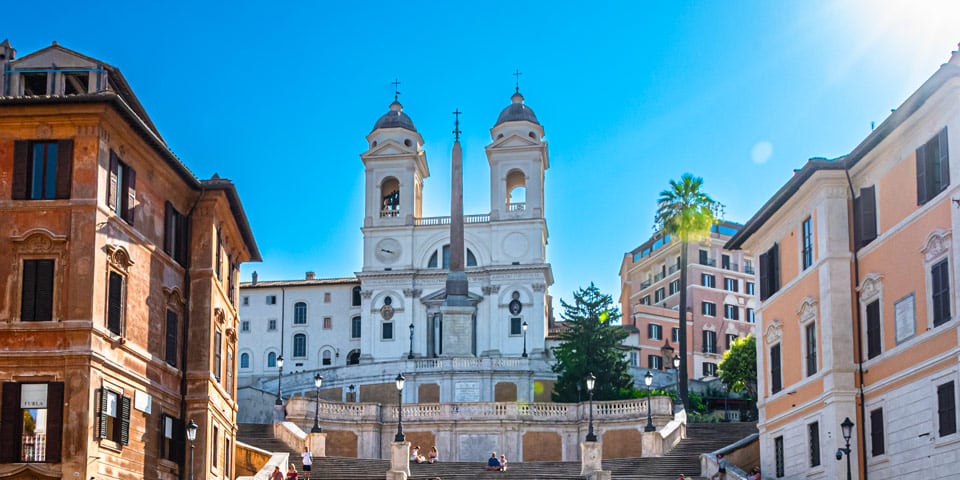

21543 views

| Opening Hours |
Sunday:
-
Monday:
-
Tuesday:
-
Wednesday:
-
Thursday:
-
Friday:
-
Saturday:
-
|
|---|---|
| Closest bus stops |
|
| Closest subway stations | |
| Address | Piazza della Trinità dei Monti, 3, Roma |
| Website | trinitadeimonti.net |
The Church of Trinità dei Monti, situated at the top of the Spanish Steps, is a beautiful French Renaissance church with an iconic twin-towered facade. Built-in the 16th century, the church offers panoramic views of Rome from its elevated position. Known for its elegant architecture and historical significance, it is a prominent landmark in the city’s heart.
Contents
ToggleThe Church of Trinità dei Monti has a rich history dating back to the 16th century. Commissioned by King Louis XII of France, the church was constructed between 1502 and 1519 under the direction of the French architect Louis XII. Its construction was part of the French presence in the city, and the church is a notable example of French Renaissance architecture in Rome.
The Church of Trinità dei Monti in Rome has historical associations with the Order of Minims, a Catholic religious order founded by Saint Francis of Paola in the 15th century. The Minims, officially known as the Order of Minims (O.M.), is a monastic order within the Roman Catholic Church that emphasizes a life of humility and austerity.
In the case of Trinità dei Monti, King Louis XII of France sponsored the church’s construction in the early 16th century. The French king invited the Minims to establish a friary adjacent to the church, and they played a significant role in the early history of the Trinità dei Monti. The friary served as the residence for the friars of the Order of Minims, who were responsible for the church’s spiritual life and its surroundings.
Over time, the church and friary underwent various changes and renovations. While the Minims were initially associated with Trinità dei Monti, the church eventually came under the care of the Observant Franciscans. Despite the shift in religious orders, the church retained its historical and cultural significance.
Today, the Church of Trinità dei Monti is a prominent landmark in Rome, known for its French Renaissance architecture, art, and historical connections to the Minims and the Observant Franciscans.
In addition to its architectural significance, the Church of Trinità dei Monti holds cultural and artistic importance. The interior features notable works of art, including frescoes by Daniele da Volterra and a crucifixion scene by Daniele da Volterra and Pietro da Cortona. The church and its location at the top of the Spanish Steps make it a popular destination for religious pilgrims and tourists exploring Rome’s historic and artistic treasures.
Read also about San Clemente Church.
The interior of the Church of Trinità dei Monti in Rome is characterized by its harmonious blend of Renaissance and Baroque elements, reflecting the transitions and renovations it has undergone over the centuries.
The church’s central nave features a bright and spacious interior with several side chapels adorned with elegant decorations. The high altar, dating back to the 16th century, is a notable focal point, displaying a crucifixion scene attributed to Daniele da Volterra and flanked by Saint John the Baptist and Saint John the Evangelist statues.
The church also houses several valuable works of art, including frescoes and paintings. Notable among them are the frescoes by Daniele da Volterra, an Italian Renaissance artist, in the Chapels of St. John the Baptist and St. Anne. The Chapel of St. Anne, in particular, features scenes from the life of the Virgin Mary. Additionally, visitors can admire the Crucifixion scene painted by Daniele da Volterra and Pietro da Cortona, which graces the chapel ceiling.
The elegant and tranquil atmosphere of Trinità dei Monti’s interior and artistic treasures give visitors a glimpse into this historic church’s rich cultural and religious heritage overlooking the iconic Spanish Steps in the heart of Rome.
Read also: Best Books on Roman History and Ancient Rome.
Visiting the Church of Trinità dei Monti is a relatively straightforward process, and you can enjoy the church and the surrounding area, including the iconic Spanish Steps, the Trevi Fountain (less than 10-minute walk), and Villa Borghese. Here’s a guide on how to visit Trinità dei Monti:
Read also: Districts of Rome
Author: Kate Zusmann
This website uses cookies. For more info read the cookies policy
Rome.us © 2025. Created with love by Roman experts and guides.